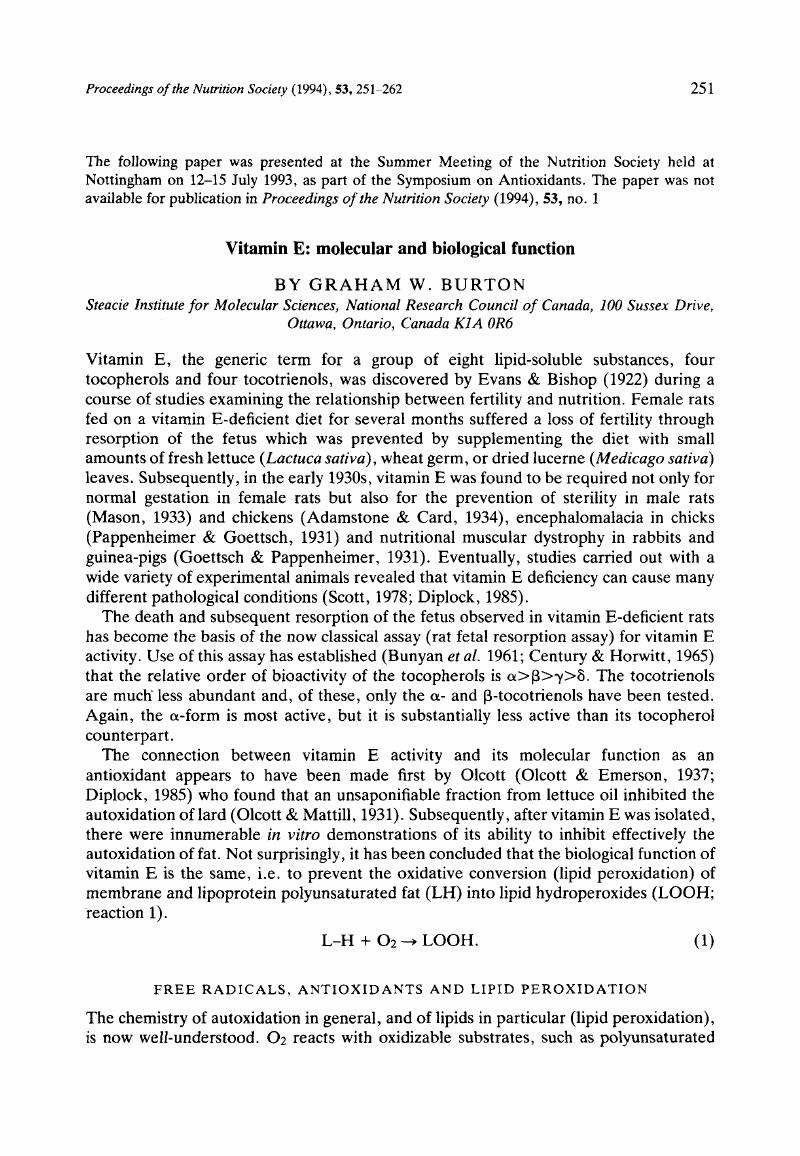Crossref Citations
This article has been cited by the following publications. This list is generated based on data provided by Crossref.
Kelly, M. J.
and
Richardson, W.
1996.
Possible mechanisms for the protective action of α‐tocopherol in vascular hypoxia.
Journal of Autonomic Pharmacology,
Vol. 16,
Issue. 2,
p.
87.
Bijur, Gautam N.
Ariza, Maria E.
Hitchcock, Charles L.
and
Williams, Marshall V.
1997.
Antimutagenic and promutagenic activity of ascorbic acid during oxidative stress.
Environmental and Molecular Mutagenesis,
Vol. 30,
Issue. 3,
p.
339.
Qi, Guang-Hai
and
Sim, J. S.
1998.
Natural Tocopherol Enrichment and Its Effect inn−3 Fatty Acid Modified Chicken Eggs.
Journal of Agricultural and Food Chemistry,
Vol. 46,
Issue. 5,
p.
1920.
SURAI, P.F.
IONOV, I.A.
KUKLENKO, T.V.
KOSTJUK, I.A.
ACPHERSON, A.M
SPEAKE, B.K.
NOBLE, R.C.
and
SPARKS, N.H.C.
1998.
Effect of supplementing the hen's diet with vitamin A on the accumulation of vitamins A and E, ascorbic acid and carotenoids in the egg yolk and in the embryonic liver.
British Poultry Science,
Vol. 39,
Issue. 2,
p.
257.
Dabrosin, Charlotta
and
Öllinger, Karin
1998.
Protection by α-tocopherol but not ascorbic acid from hydrogen peroxide induced cell death in normal human breast epithelial cells in culture.
Free Radical Research,
Vol. 29,
Issue. 3,
p.
227.
Walker, MK
Vergely, C
Lecour, S
Abadie, C
Maupoil, V
and
Rochette, L
1998.
Vitamin E analogues reduce the incidence of ventricular fibrillations and scavenge free radicals.
Fundamental & Clinical Pharmacology,
Vol. 12,
Issue. 2,
p.
164.
Munday, John S.
James, Kerry A.
Fray, Linley M.
Kirkwood, Stephen W.
and
Thompson, Keith G.
1999.
Daily supplementation with aged garlic extract, but not raw garlic, protects low density lipoprotein against in vitro oxidation.
Atherosclerosis,
Vol. 143,
Issue. 2,
p.
399.
Nargi, Jennifer L.
Ratan, Rajiv R.
and
Griffin, Diane E.
1999.
p53-Independent Inhibition of Proliferation and p21Waf1/Cip1-Modulated Induction of Cell Death by the Antioxidants N-acetylcysteine and Vitamin E.
Neoplasia,
Vol. 1,
Issue. 6,
p.
544.
Andreassen, Ole A
Weber, Christine
and
JØrgensen, Hugo A
1999.
Coenzyme Q10 Does Not Prevent Oral Dyskinesias Induced by Long-Term Haloperidol Treatment of Rats.
Pharmacology Biochemistry and Behavior,
Vol. 64,
Issue. 3,
p.
637.
van Dam, P.Sytze
Bravenboer, Bert
van Asbeck, B.Sweder
Marx, Joannes J.M
and
Gispen, Willem Hendrik
1999.
High rat food vitamin E content improves nerve function in streptozotocin-diabetic rats.
European Journal of Pharmacology,
Vol. 376,
Issue. 3,
p.
217.
Barsh, Russel Lawrence
1999.
Chronic health effects of dispossession and dietary change: Lessons from North American hunter‐gatherers.
Medical Anthropology,
Vol. 18,
Issue. 2,
p.
135.
Hegbrant, J.
and
Bengtsson, U. Hultkvist
1999.
Vitamin C and E as Antioxidants in Hemodialysis Patients.
The International Journal of Artificial Organs,
Vol. 22,
Issue. 2,
p.
69.
Koul, Ashwani
Mishra, Anju
and
Nehru, Bimla
2000.
Modulation of Oxidative Stress by Ascorbic Acid and/or α-Tocopherol.
Journal of Nutritional & Environmental Medicine,
Vol. 10,
Issue. 3,
p.
233.
Eggersdorfer, Manfred
Adam, Geo
John, Michael
Hähnlein, Wolfgang
Labler, Ludvik
Baldenius, Kai-U.
von dem Bussche-Hünnefeld, Linda
Hilgemann, Eckhard
Hoppe, Peter
Stürmer, Rainer
Weber, Fritz
Rüttimann, August
Moine, Gérard
Hohmann, Hans-Peter
Kurth, Roland
Paust, Joachim
Hähnlein, Wolfgang
Pauling, Horst
Weimann, Bernd-Jürgen
Kaesler, Bruno
Oster, Bernd
Fechtel, Ulrich
Kaiser, Klaus
de Potzolli, Bernd
Casutt, Michael
Koppe, Thomas
Schwarz, Michael
Weimann, Bernd-Jürgen
Hengartner, Urs
de Saizieu, Antoine
Wehrli, Christof
and
Blum, René
2000.
Ullmann's Encyclopedia of Industrial Chemistry.
Zhang, Peng
and
Omaye, Stanley T.
2000.
β-Carotene and protein oxidation: effects of ascorbic acid and α-tocopherol.
Toxicology,
Vol. 146,
Issue. 1,
p.
37.
Bramley, P?M
Elmadfa, I
Kafatos, A
Kelly, F?J
Manios, Y
Roxborough, H?E
Schuch, W
Sheehy, P?J?A
and
Wagner, K-H
2000.
Vitamin E.
Journal of the Science of Food and Agriculture,
Vol. 80,
Issue. 7,
p.
913.
Estornell, Ernesto
Tormo, José R.
Marín, Pilar
Renau-Piqueras, Jaime
Timoneda, Joaquín
and
Barber, Teresa
2000.
Effects of vitamin A deficiency on mitochondrial function in rat liver and heart.
British Journal of Nutrition,
Vol. 84,
Issue. 6,
p.
927.
Csallany, A. Saari
Kim, Song‐Suk
and
Gallaher, Daniel D.
2000.
Response of urinary lipophilic aldehydes and related carbonyl compounds to factors that stimulate lipid peroxidation in vivo.
Lipids,
Vol. 35,
Issue. 8,
p.
855.
Zhang, P.
and
Omaye, S.T.
2001.
DNA strand breakage and oxygen tension: effects of β-carotene, α-tocopherol and ascorbic acid.
Food and Chemical Toxicology,
Vol. 39,
Issue. 3,
p.
239.
Van Houte, Hilde
de Hoffmann, Edmond
Van Veldhoven, Paul P.
Mannaerts, Guy P.
Carchon, Hubert
Baes, Myriam I.
and
Declercq, Peter E.
2001.
Oxidative catabolism of α‐tocopherol in rat liver microsomes.
Lipids,
Vol. 36,
Issue. 4,
p.
367.



